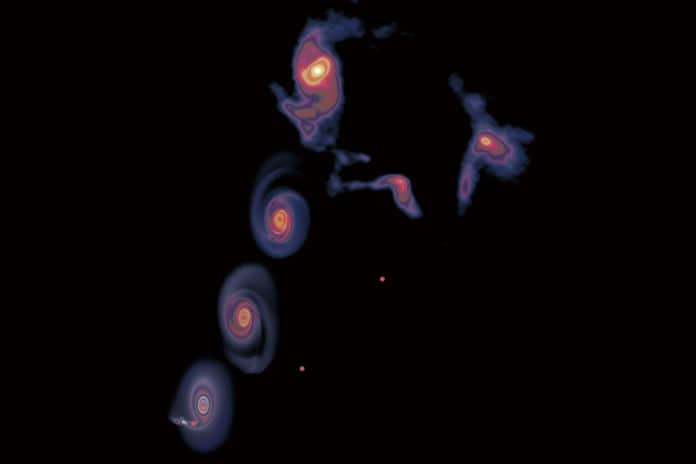Accretion disks, also known as ‘protostellar disks,’ are key components in star formation. These disks continuously feed gas into protostars from the environment. In this sense, they are stellar cradles where stars are born and raised.
Recently, a team of astronomers reported the discovery of a massive protostellar disk in the Milky Way’s center. The team also determined how its spiral arms were formed.
The disk has a diameter of about 4,000 astronomical units and surrounds a forming, early O-type star with a mass about 32 times that of the Sun.
The discovery was made using high-resolution observational data from the Atacama Large Millimeter/submillimeter Array (ALMA). The team includes Dr. LU Xing, an associate researcher from the Shanghai Astronomical Observatory (SHAO) of the Chinese Academy of Sciences, and collaborators from Yunnan University, the Harvard-Smithsonian Center for Astrophysics, and the Max Planck Institute.
According to the research, this disc was agitated by a close encounter with a neighboring object, causing the spiral arms to develop. This discovery suggests that big stars may originate similarly to lower-mass stars via accretion discs and flybys.
Using observations from ALMA, the research team achieved a resolution of 40 milliarcseconds. With these high-resolution, high-sensitivity ALMA observations, the team discovered an accretion disk in the Galactic Center.
The discovery suggests that massive early-O-type stars go through a formation phase involving accretion disks, and this conclusion is valid for the unique environment of the Galactic Center.
The fascinating fact is that the disk’s two spiral arms are visible. Such arms are usually found in spiral galaxies but rarely in protostellar disks. Spiral arms in accretion disks are generally formed because of fragmentation induced by gravitational instability.
However, this newly discovered protostellar disk is hot and turbulent, allowing it to balance its gravity.
In trying to explain this phenomenon, the researchers proposed an alternate explanation—that the spirals were induced by external perturbation. The researchers proposed this explanation after detecting an object of about three solar masses—possibly the source of the external perturbation—several thousand astronomical units away from the disk.
The team verified this proposition by calculating several dozen possible orbits of this object. They found that only one of these orbits could perturb the disk to the observed level.
They subsequently carried out a numerical simulation on the high-performance supercomputing platform of the Shanghai Astronomical Observatory to trace the trajectory of the intruding object. They successfully reproduced the entire history of the object flying by the disk more than 10,000 years ago when it would have stirred up spirals in the disk.
Dr. LU said, “The nice match among analytical calculations, the numerical simulation, and the ALMA observations provide robust evidence that the spiral arms in the disk are relics of the flyby of the intruding object.”
“This finding demonstrates that accretion disks at early evolutionary stages of star formation are subject to frequent dynamic processes such as flybys, and these processes can substantially influence the formation of stars and planets.”
“The formation of this massive protostar is similar to its lower-mass cousins like the Sun, with accretion disks and flyby events involved. Although stellar masses are different, certain physical mechanisms in star formation could be the same. This provides important clues to solving the mystery of massive star formation.”
Journal Reference:
- Lu, X., Li, GX., Zhang, Q. et al. A massive Keplerian protostellar disk with flyby-induced spirals in the Central Molecular Zone. Nat Astron (2022). DOI: 10.1038/s41550-022-01681-4
